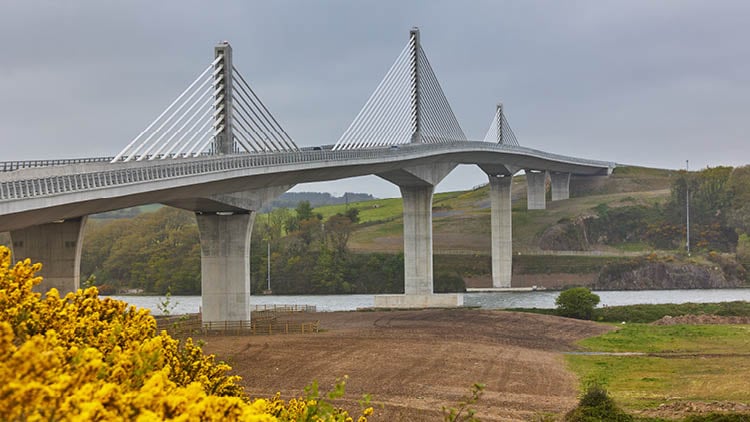Why long-term planning and delivery matter now more than ever.
Economic competitiveness drives productivity, innovation and investment, securing continued prosperity and raising living standards. Competitiveness is especially important for small, open, export-led economies such as Ireland’s. Ireland’s economy is among the most competitive in the world but recent analysis by the Institute for Management Development (IMD) indicates relative decline. Ranked the second most competitive economy in the world in 2023, Ireland fell to seventh in the rankings 2025, as discussed in more detail in our recent Quarterly Economic Digest. In this insight, we consider the role of infrastructure in driving Ireland’s competitiveness.
World Competitiveness Ranking

(Source: IMD)
Infrastructure matters
The IMD assessment indicates that infrastructure quality and prices are the biggest factors weighing on Ireland’s economic competitiveness. Of the 69 countries surveyed, Ireland ranks 46th on prices, while Ireland’s basic infrastructure (e.g. transport, energy and water) ranks 44th globally, down six places in one year. This view is supported by analysis by the Irish Fiscal Advisory Council, which finds that Ireland’s infrastructure stock is 25% below the average of high-income countries.1
As the chart above shows, infrastructure quality is highly correlated with a country’s competitiveness. Furthermore, infrastructure has a significant impact on prices, with the Central Bank of Ireland’s Deputy Governor recently noting that in the absence of higher housing supply, house prices and rents will increase. This will place upward pressure on wages and the cost of doing business, ultimately making Ireland’s exports more expensive in a global market.2
In tackling its persistent infrastructure deficit, Ireland can drive down the cost of doing business while building on its existing strengths (e.g. institutions and educated work force), achieving greater competitiveness.
“Ireland cannot afford to delay critical infrastructure. A rolling 30–50-year plan, backed by multi-annual funding and delivery capacity, is essential to maintain competitiveness and secure sustainable growth.”
Robert Costello, Partner, Capital Projects and Infrastructure at PwC IrelandThe price of power
As a high-tech, advanced, export-led economy, Ireland is highly dependent on its energy sector. The reliable availability of clean and affordable energy underpins Ireland’s ability to compete on a global stage. Despite this, it’s becoming increasingly evident that Ireland’s investment in the energy sector has not kept pace with demand.
This has left Ireland’s economy vulnerable to global events. For example, Russia’s invasion of Ukraine in 2022 led to a surge in natural gas prices. With close to half of Ireland’s electricity produced using natural gas, almost all of which is imported, electricity bills ballooned, squeezing businesses and consumers and driving inflation across the wider economy. In 2024, Ireland’s electricity prices before taxes were the highest in the EU, 73% higher than the EU average.3
Greater investment in a diversified set of energy sources, including wind, solar, biomethane and in energy storage, will help reduce vulnerability to global shocks. However, it will not necessarily drive energy costs down in the short- to medium-term. This is due to the need to fund significant investment over the coming decades.
For example, renewable energy projects, which are capital intensive, tend to have higher up-front costs and lower operational costs than traditional fossil-fuel based systems. The development of renewable energy sources also requires significant investment in electricity transmission and storage infrastructure. With a sparse, widely dispersed population outside the Greater Dublin Area, developing Ireland’s energy infrastructure is more costly per person than in more densely populated countries, and this ultimately shows up in electricity costs.
While the up-front investment required to make the energy transition will be costly in the short- to medium-term, it is worth noting that a failure to invest will likely leave Ireland’s energy costs among the highest in Europe. An example of how Ireland’s underdeveloped electricity grid currently drives costs up is corporate power purchase agreements (CPPA). PwC analysis finds that Ireland has some of the highest CPPA costs in the EU, as shown in the table below. Part of this can be attributed to the electricity grid infrastructure’s inability to accommodate renewable energy projects at their full capacity. Often these projects will be capped in how much energy they can produce, so developers need to recover their costs over a smaller number of units, leading to higher costs per unit. All things being equal, if investment is made in grid infrastructure to accommodate a higher level of renewable energy, the cost per unit of energy should decrease.
CPPA price ranges for a sample of EU countries
| Country | Average (€/MWh) |
| Ireland | €115-147 |
| Latvia | €76-82 |
| France | €62-68 |
| Denmark | €43-81 |
| Germany | €45-74 |
| Sweden | €36-42 |
(Source: PwC analysis)
The costs of inaction don’t end there. Delays to investment in energy infrastructure will have knock-on implications for Ireland’s ability to meet its legally binding climate targets. This will result in additional costs through the necessity to purchase carbon credits and/or pay substantial fines.
Similar challenges are faced in other critical sectors, including housing, transport and water, where significant investment is required to close Ireland’s infrastructure gap and place Ireland’s economic prosperity on a more sustainable footing. Delays to water infrastructure delivery, for example, has knock-on implications for Ireland’s housing development, further exacerbating the current crisis and potentially impacting Ireland’s economy as it becomes more difficult to both retain and attract talented workers.
Delivering on such critical infrastructure also has wider benefits for society. It has been estimated that The Irish Water Western Supply project will produce an economic benefit of €12.25 for every €1 invested.4 Infrastructure investment that is well-planned, appropriately prioritised and coordinated, and delivered in a cost-effective and timely manner will not only drive economic activity, it will also help maintain Ireland’s competitiveness.
“Our recent growth in corporate tax receipts should fund infrastructure for the long-term. Allocating these volatile revenues to dedicated funds ensures consistent investment, even through economic downturns.”
Sinead Lew, Corporate Tax Partner, PwC IrelandPlanning, prioritising and delivering
Closing Ireland’s infrastructure deficit will not happen overnight. Careful attention must be paid to planning, prioritising and delivering investment at sustained scale. Avoiding the emergence of new gaps requires that this process is continual, taking a long-term view, identifying demand, insulating investment from economic cycles, and building and maintaining the capacity to deliver.
Ireland has taken steps to be more proactive with the development of infrastructure. The National Development Plan and the National Planning Framework reflect governments’ longer-term strategic thinking regarding infrastructure. However, delivering unprecedented investment requires effective resourcing, which is only made possible through careful prioritisation and sequencing of investment.
Consider how the deployment of construction workers to one megaproject will inevitably reduce the skilled labour available to another megaproject. In the context of a housing crisis, the ability of inward migration of skilled construction workers to act as a relief valve is severely constrained. A rolling 30-50-year, prioritised plan for critical infrastructure projects, enabled by long-term funding commitments — insulating investment from the economic cycle and developing productive capacity — is essential to securing Ireland’s continued economic prosperity and maintaining economic competitiveness.
Funding infrastructure delivery through the entire economic cycle is essential. The Government has taken positive first steps to ensure long-term sustainability of infrastructure projects. The recent establishment of the Infrastructure, Climate and Nature Fund (ICNF) and the Future Ireland Fund (FIF) are key steps in managing the pro-cyclicality of capital spending and will enable investment in infrastructure even through difficult economic times.
While the ICNF is intended to support environmental projects, the FIF is broader in its purpose and aims to support consistent and sustainable State expenditure past 2041. The development of both funds is a step in the right direction as an approach to long-term infrastructure investment. Infrastructure is long term in nature and the benefits accrue over 50+ years in many cases so our recent once off tax receipts and additional corporation tax are ideal sources of funding. Volatile by nature, such tax receipts are not suitable to support current expenditure or certain ongoing capital expenditures. However, allocating these receipts to infrastructure funds allows capital to be drawn down over a longer period, ensuring consistent and continuous investment.
A long-term plan for infrastructure delivery also gives certainty to the market, attracting private investment, which has a central role to play. Where certainty of pipelines for projects and programmes is given, the allocation of risk for investment can be more appropriately considered, incentivising such investment. Similarly, having a long-term pipeline of work means lessons learnt can be taken from project to project, allowing for streamlining and quicker turnarounds.
Standardising design in planning and execution allows for quicker planning procedures and construction, incentivising the use of standard solutions, where possible. Scale and standardisation have already been shown as a success within the telecoms market, through both private and public investment, and this may prove relevant to the housing sector.
Having a long-term plan is necessary, but not sufficient. Without implementation and delivery, plans and frameworks simply cannot close the gap. Successful implementation begins long before shovels hit the ground. Planning permission and funding approval are two examples of essential but often challenging steps in the delivery of critical infrastructure.
Planning permission requirements seek to control development such that it suitable for its location, sustainable and in line with policy. However, challenges with the functioning of this system have been well documented and whether recent reforms will bear fruit remains to be seen.
The requirements to receive funding approval, as set out in the Infrastructure Guidelines, are in place to improve value for money for taxpayers and allocate resources to where the need is greatest. This process has proved to be slow and has created uncertainty over the infrastructure pipeline with far-reaching implications, not least for the market actors interested in participating in the delivery of that infrastructure.
Good governance is required to provide robust oversight, but excessive oversight can also hinder the delivery of projects. A balance needs to be struck between over-governance and risk aversion and operational agility. While accountability is needed through project governance, accountability for failure to deliver projects should also be at the forefront of the State’s mind.
At what cost?
The cost of failure to deliver critical infrastructure is not just the sunk cost (i.e. costs that have been incurred and cannot be recovered). Delayed projects become more costly as prices increase. Delayed projects have opportunity costs, tying up resources — including labour — that could be deployed on other critical projects. Projects that are delayed or stalled cost end-users through delays in access to the services that infrastructure enables. Indeed, it is far from true to say that a project that doesn’t proceed is a cheap one.
Where there is a demonstrated need for a project, a failure to deliver it has significant costs, both to society and to the State, which often must address the need through other means. Failure comes at great cost to our climate, as targets are missed. And ultimately, failure leads to a fall in competitiveness, lower productivity and weaker economic prospects for the country. Ireland simply cannot afford not to deliver on critical infrastructure without delay.
Footnotes
1 IFAC – Ireland’s Infrastructure Demands (Conroy and Timoney, 2024).
2 Managing the macroeconomic trade-offs of increased investment in infrastructure - Remarks by Deputy Governor of the Central Bank of Ireland, Vasileios Madouros (2024).
3 Eurostat - Electricity price statistics
4 Water Supply Project Eastern and Midlands Region (WSP EMR) Preliminary Business Case (Uisce Éireann, 2023)
Budget 2026
Securing Ireland’s future against economic headwinds.
Contact us











Menu